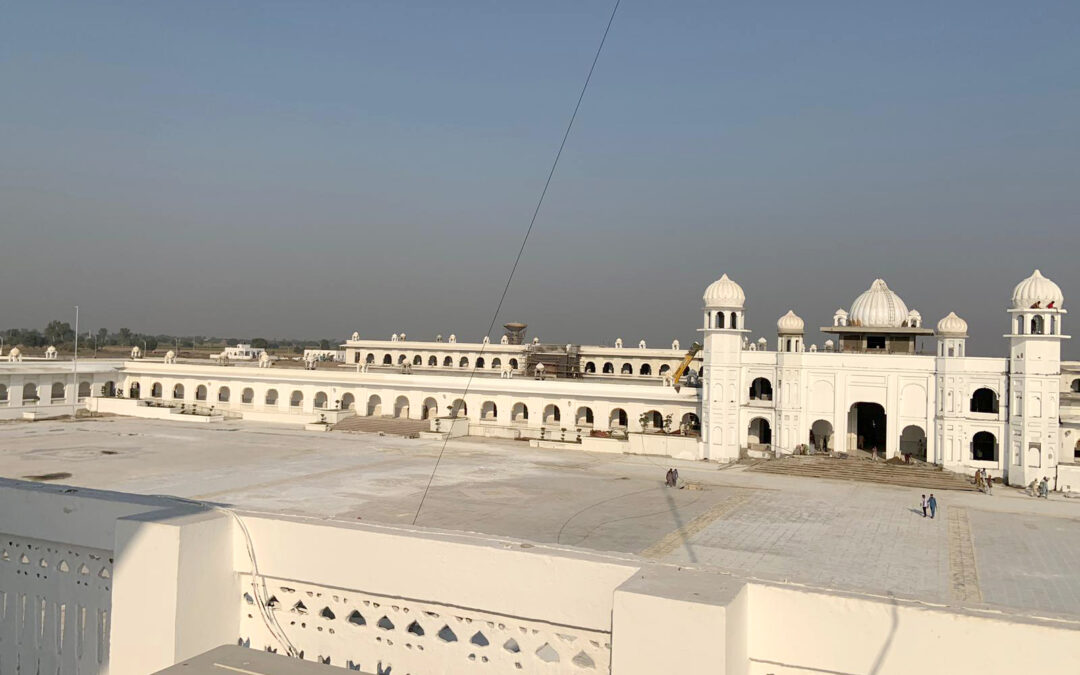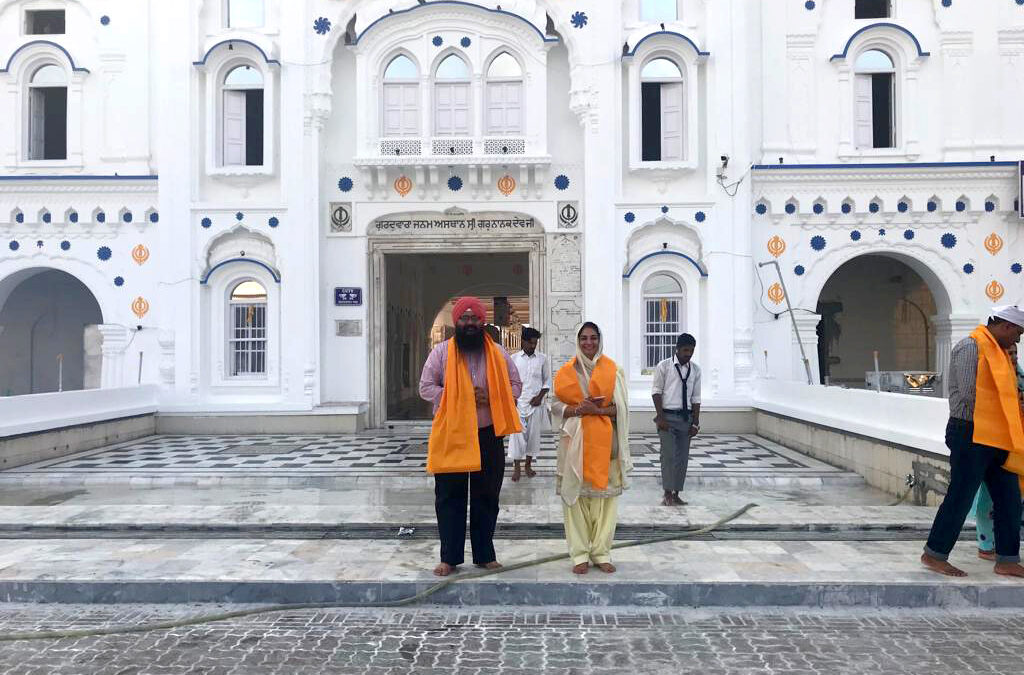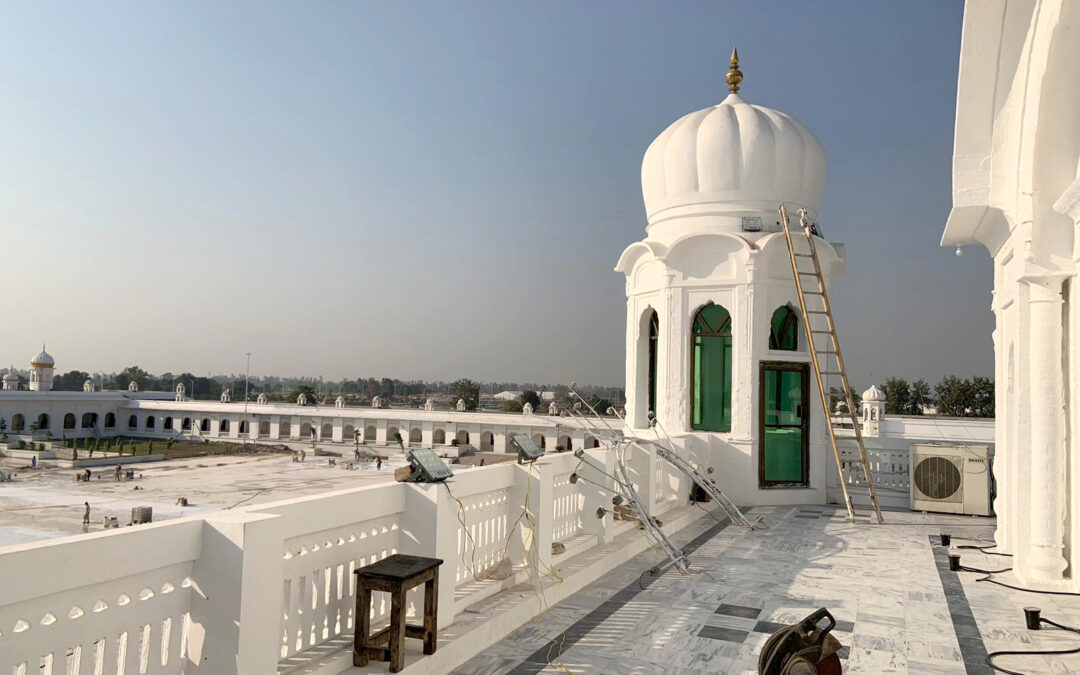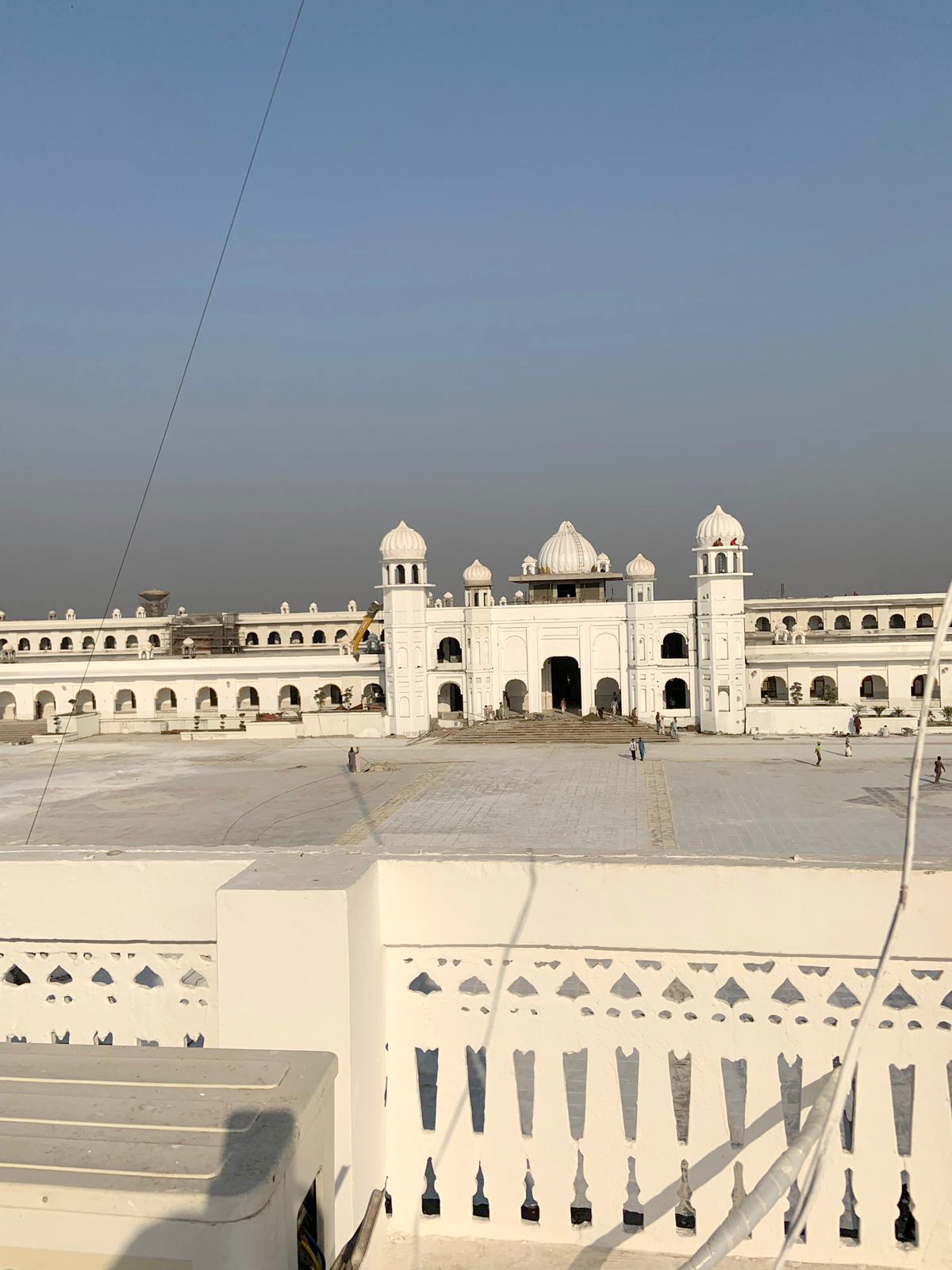
by blogadmin | Nov 11, 2019 | Blog Post, Media Publishing's, Sikhism, Year 2019
A few months ago, my wife and I decided to do the unthinkable: visit Pakistan.
Before boarding the Philadelphia-Lahore flight last month, I wrote an op-ed for Pakistan’s The Daily Times, but never anticipated the reaction on social media. Some of my fellow Indians — not only Modi devotees — were offended by my positive mentions of Pakistan and Muslims. The Patel community was most upset.
With this uncertain start, how could we believe that our maiden Pakistan visit would be such a joyous experience? From the moment we arrived we were treated like celebrities. Shopkeepers and restaurants would first refuse to accept money.
It is important to mention here that I was in a country and among people I had done my best all these years to avoid.
This side of Punjab has a lot of camels. I also observed rampant pigeon grooming for gambling. In Faisalabad (old Lyallpur), I was awestruck to see its sky blanketed by colourful kites. The city’s Gobind Pura, Nanak Pura and Harcharan Pura show its inseparable Sikh connection.
When we arrived at Lyallpur Khalsa College (now Municipal Degree College) on a late Friday afternoon, the college appeared to be closed. The security guard pointed us towards the principal who was just opening his car door. One of our local companions hurriedly approached the principal. I will never forget the principal’s words: ‘It is their college, their property. They built it. Who am I to give them permission to tour it?’
Pakistani Punjabi has always been endearing to me, even though my friends and I often made it a butt of our jokes. That its speakers found my Punjabi interesting and original was a pleasant surprise.
Outside Lahore’s Defence Raya Golf and Country Club, I was introduced to Lt Gen Zahid Ali Akbar (retd). Although 88 years of age, he seemed fit enough to finish a marathon. ‘What a joy to speak real Punjabi with you. What they speak here isn’t Punjabi. Teach them some before you leave!’ he said, pointing to my hosts.
At the Punjab Club, Lahore’s colonial hangover is unmistakable. Its dress code and no-photo policy are non-negotiable. Thanks to an invitation from Riaz Ahmad Khan, retired chief justice of the Pakistan Supreme Court, and his wife, we were allowed to visit and eat there.
It was a remarkable journey. I have lived in England as a student and visited many European and Central American countries for business and leisure. I have seen more expansive physical beauty and natural diversity, awe-inspiring infrastructure and impeccable systems. However, never before have I seen such hearty hospitality or experienced an abundance of love that so contrasted with a country’s image abroad. No wonder that we frequently asked each other, ‘Are we in Pakistan?’
– – – – – – –
This column was published online by the www.tribuneindia.com on November 09, 2019.

by blogadmin | Nov 5, 2019 | Blog Post, Media Publishing's, Sikhism, Year 2019
In an October 5, 2019 column, I wrote about the overwhelming support and love my wife Harpreet Minhas and I received from Delaware’s Pakistani community in America on learning that we were travelling to Pakistan for the first time.
Guru Nanak’s 550th birth anniversary had inspired us to make the trip-one we had previously thought impossible. As it turned out, the eight days I spent in the country so feared by many turned out to be eight of my best.
Our Qatar flight on October 23 had landed almost an hour earlier in Lahore, just past midnight. Immigration and customs were a breeze-a pleasant surprise because getting our Pakistan visas in Washington D.C. had taken us a month.
The airport’s infrastructure and overall condition reminded me of India’s Nagpur airport, which I had visited before coming to America in 1999.
Outside, our trip guide and facilitator, Irfan Raza-our Delaware friend Rubina Malik’s relative and our ride to the Pearl Continental Hotel-had not yet arrived.
Walking around, I started looking and observing and taking pictures of my first glimpses of the Lahore I had read and heard so much about. A Sikh anywhere in the world has a special bond with Lahore for historical, religious, cultural and language reasons.
A bit later, a tall, good-looking man approached me. “Sat Sri Akal Ji.”
“Sat…Sri…Akal,” I mumbled, trying hard to place this familiar face.
Is he one of my wife’s many cousins who live in the Jalandhar belt or a sibling of one of my hometown Patiala friends? His smile and sweet and friendly demeanor provided no clues.
“Sorry, you are…?”
“Irfan, Ji.”His face bloomed even more as he stretched out his right hand. His beautiful wife, Bushra, stood by his side clasping her hands like I do many times when in a gurdwara.
Before they left after checking us in the hotel, we discussed how to overcome various uncertainties we may face arising from Maulana Fazlur Rehman’s call for nationwide protests. We decided to mitigate possible risks by visiting destinations outside Lahore first.
As planned, after we had bathed, changed, slept a few hours and eaten, Irfan and Bushra picked us up to go to Gurdwara Janam Asthan in Nankana Sahib. Irfan was driving.
We headed west and soon reached a bridge over a dry riverbed.
“India stopped Ravi’s water,” Irfan said, anticipating my question.
The dehydrated Ravi illustrated the rocks and stones and ravines in India and Pakistan relations. In my heart I asked Guru Nanak, “Will there be a day when these two neighbours will drown their rocks and stones and flow together in peace and harmony?”
After about three hours we reached the gurdwara on the site where 550 years earlier Guru Nanak Dev was born. I entered the compound and continued to walk towards the gurdwara. A man in his sixties, coming from the opposite side, greeted me.
“I am Abdul Rasheed. My elders revered Baba Nanak. Baba Fareed is our saint; he and Nanak are the same, they taught us. Sardarji, you are fortunate that he has summoned you to his darbar.”
Abdul’s wear was simple and his manner rustic, but what he said was divine.
“This is my first time. Do you live here in Nankana Sahib?” I asked.
“No, Samundari, near Lyallpur. This is my first time as well, though I have been intending to visit for decades.”
“Ah! Because it is his 550th, that’s why you came as I did from America?”
“No, I didn’t know it. Bhaiji (Sikh priest) inside, who fed us food, water and tea, told us. Sardarji, you came because he sent for you. I came because he called me, and he called me now. How could I come before?”
With that, he walked away quietly humming something.
When I came out after paying my obeisance, a group of seven non-Sikh men asked me for a picture. Another family requested the same when we were collecting our shoes.
Such requests for pictures by men and women, boys and girls, individuals and families, young and old, on foot or a bike or in a car grew in the days ahead. Why was I such a celebrity? Honestly, I don’t know.
For instance, the next day, before we reached Kartarpur Sahib, a camel owner in Narowal asked me for a picture. On arrival in the compound of the Gurdwara Darbar Sahib, we were mobbed by the national and international media present there rafter covering the signing of the agreement between India and Pakistan to operationalise Kartarpur Corridor. In Faisalabad, on Friday, visiting Lyallpur Khalsa College (now Municipal Degree College) was one of our top priorities. When we reached its gate, the college appeared to be closed and the helpless security guard pointed us towards the principal about to leave in his car.
When Aslam from our local host group approached him, I will never forget his reply: “It is their college, their property. They built it. Who am I to give them permission?”
Other than absent bars and wine shops and Urdu street signs, it is difficult to tell the two Punjabs apart. East Punjab doesn’t have a large and developed city like Lahore, soaked in grand history. Its DHA developments may have no match in northern India, while the Packages Mall could be a shopping destination anywhere on the globe.
I have lived in England as a student and visited many European, North, South and Central American countries for business and leisure. Australia and Asia as well. I have seen more expansive physical beauty and natural diversity, awe-inspiring infrastructure and impeccable systems.
However, never before have I seen such hearty hospitality or experienced an abundance of love that so contrasted with a country’s image abroad. No wonder that Harpreet and I frequently asked each other, “Are we in Pakistan?”
– – – – – – –
This column was published online by the www.dailytimes.com.pk on November 05, 2019.

by blogadmin | Nov 5, 2019 | Sikhism, Year 2019
Hi folks, first of all, I would like to thank The Almighty Shri Guru Nanak Dev for making this tour a reality which a devotee can only dream of. Yes, today I am sharing some glimpses of my recent visit to Shri Nankana Sahib, the birthplace of Shri Guru Nanak Dev and also the Kartarpur Sahib in Pakistan.
On 23rd of November, we reached Allama Iqbal International Airport, Lahore, Pakistan and we received overwhelming response and Hospitality from the Pakistani people which completely refreshed us and our fatigue has gone away. When we are heading to visit the shrines we went across the Ravi river which is almost dried these days and coincidently it’s the same Ravi river where Shri Guru Nanak Dev Sahib laid the foundation of Sikh commune on its sides.
Sri Nankana Sahib is located 91 kilometres from Lahore in the district of Nankana Sahib which itself is named after Shri Guru Nanak Dev we went there hiring a local cab and as we are heading towards the ultimate pilgrimage of Sikh religion our driver told us many things about the pious city. We consider ourselves very lucky to have visited the Shrine and we are so mesmerized by the Peaceful and calming atmosphere of the Gurdwara where you can still feel the Spiritual influence of Shri Guru Nanak Dev as we say it’s in the air.
I feel very blessed to have witnessed such defining events of modern history related to Sikh community across the globe. Although there is some time left for the events to actually happen. As we all know the 550th birth anniversary of Shri Guru Nanak Sahib is around the corner and as decided by Government of India and Pakistan, that Kartarpur corridor will be made functional before the 550th anniversary for the Sikh pilgrims to visit Gurudwara Darbar Sahib Kartarpur which is also a major Shrine along with the Nankana Sahib.
On 9th of November the corridor will be inaugurated by the prime minister of Pakistan Mr Imran Khan, the pilgrims will now be able to visit the Kartarpur Gurdwara without any visa but a passport is a must. The total length of the corridor is 6 kilometres from Dera Baba Nanak Sahib, Gurdaspur District, Punjab, India to Kartarpur Gurdwara Darbar Sahib, Pakistan out of which four kilometres are in Pakistan and two kilometres are in India. This is a very welcome move on part of both the governments which is welcomed by the Sikh community all over the globe.

by blogadmin | Nov 4, 2019 | Blog Post, Media Publishing's, Sikhism, Year 2019
On 24 October, my wife and I had the good fortune of visiting Kartarpur Sahib gurdwara – before it opens to Indian pilgrims on 8 November.
We travelled from Delaware to Lahore a day before and left for Kartarpur the following morning. There was a lot of construction activity going on, but it was wonderful to get a first look at Darbar Sahib.

What we will cherish most is the kind of hospitality and warmth we received from the Pakistanis, from the security people at the entrance of the gurdwara. We were greeted with warmth and joy everywhere we went. It was a pleasure being at Kartarpur.
We were greeted with a white expanse upon entering the premises. It was amazing to see the commitment of the local and central government in finishing up the work before the inauguration. There was a road being constructed for the pilgrims’ entry, and the library was almost furnished too. The experience was nothing short of surreal.

Construction underway at the gurdwara.
It was most touching to see local people from Lahore and its neighbourhood welcoming and helping us, making sure we had a great time.
This visit was something that we had desired and wanted for a long time, but we’d never thought that such a day would come when we’d have the opportunity to visit the holy destination – that too before the 550th birth anniversary of Guru Nanak Dev.
We were also lucky to have visited Nankana Sahib, the birthplace of Guru Nanak Dev.
Our purpose in coming here has been fulfilled in a joyous and beautiful way.
– – – – – – –
This column was published online by the www.thequint.com on November 04, 2019.

























































Recent Comments